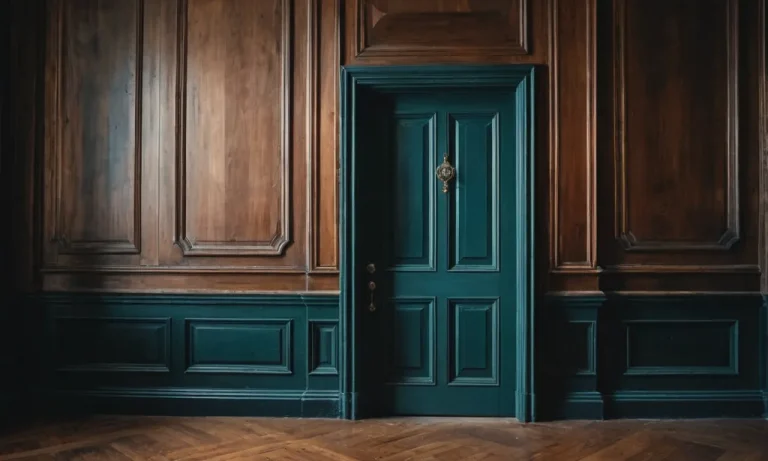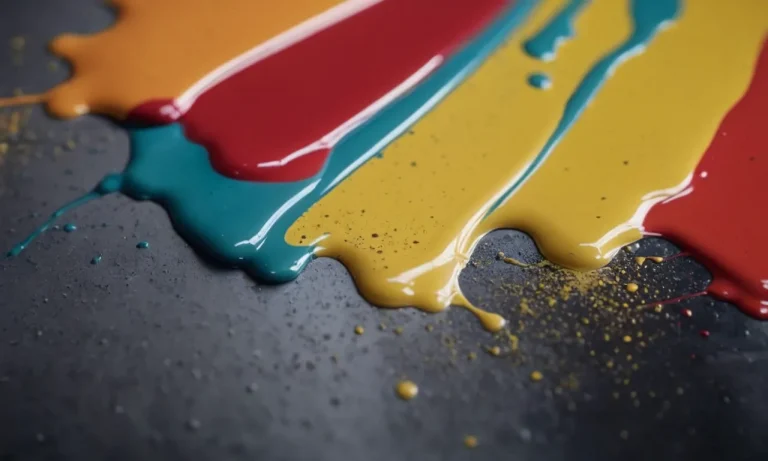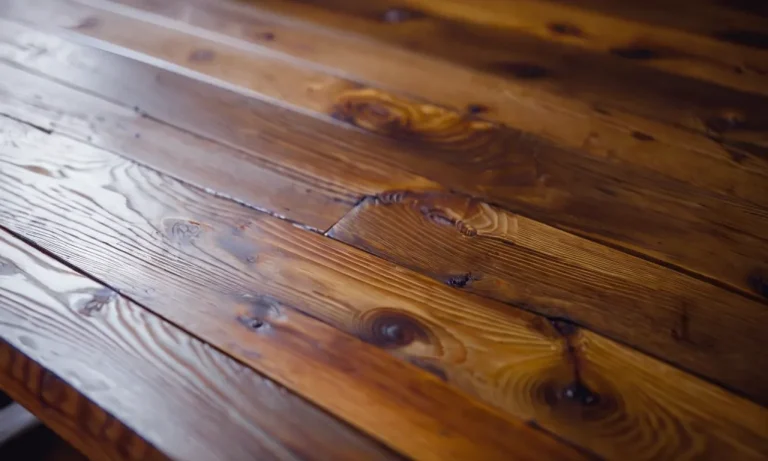How To Remove Mold From Furniture: A Step-By-Step Guide
Mold on furniture is an annoying and potentially hazardous problem that many homeowners face. If you’ve noticed mold growing on any of your furniture, don’t panic – with the right products and techniques, you can get rid of it.
If you’re short on time, here’s a quick answer to your question: To remove mold from furniture, start by vacuuming up any visible mold. Then, mix together water and detergent or bleach, and scrub the moldy areas. Let the solution sit for 10 minutes before wiping it away.
Afterward, allow the furniture to fully air dry before using again.
In this comprehensive guide, we’ll walk through all the steps for safely and effectively removing mold from furniture. We’ll cover how to identify mold, prep your workspace, mix your cleaning solutions, scrub away stubborn spores, ensure mold is fully eliminated, and prevent it from coming back.
Identifying Mold on Furniture
Look for visible growth
One of the most obvious signs of mold on furniture is visible growth. Mold can appear as patches of black, green, or white fuzziness on the surface of your furniture. These patches can be small or large, depending on the extent of the mold infestation.
If you notice any suspicious growth on your furniture, it’s important to take immediate action to prevent further spread.
Check for musty odors
In addition to visible growth, mold on furniture often produces a distinct musty odor. If you detect a strong, unpleasant smell coming from your furniture, it could be a sign of mold. This odor is caused by volatile organic compounds (VOCs) released by mold spores.
If you notice a musty smell, it’s essential to investigate further to determine if mold is present.
Examine underneath furniture
Mold can also hide underneath furniture, especially in damp or humid environments. Lift up cushions, turn over chairs or tables, and inspect the underside of your furniture for any signs of mold. Pay close attention to areas that are in direct contact with the floor or walls, as these tend to be more prone to mold growth.
It’s worth noting that mold can sometimes be difficult to detect, especially if it’s hidden in hard-to-reach areas. In such cases, it may be helpful to hire a professional mold inspector to conduct a thorough assessment of your furniture.
For more information on identifying mold on furniture, you can visit www.epa.gov/mold.
Preparing Your Workspace
Work in a well-ventilated area
When removing mold from furniture, it is important to work in a well-ventilated area. Mold spores can be harmful if inhaled, so proper ventilation is crucial. Open windows and doors to allow fresh air to circulate.
If possible, use fans to increase airflow and help in drying the furniture after cleaning. This will not only prevent the spread of mold spores but also help in maintaining a safe and healthy environment for the removal process.
Protect floors and surroundings
Mold removal can be a messy process, so it is important to protect your floors and surroundings. Place plastic sheets or drop cloths on the floor and furniture nearby to catch any drips or debris that may result from the cleaning process.
This will prevent the mold from spreading to other areas of your home and make the cleanup easier. Additionally, consider using gloves, goggles, and a mask to protect yourself from coming into direct contact with the mold and its spores.
Gather your supplies
Before you start removing mold from furniture, gather all the necessary supplies. This will ensure that you have everything you need within reach and avoid any interruptions during the cleaning process. Some common supplies you may need include:
- Mold cleaner: Choose a mold cleaner specifically designed for furniture, such as a mildew remover or a mixture of water and vinegar. Avoid using bleach, as it can damage the furniture.
- Soft brush: Use a soft-bristled brush like a toothbrush or a scrub brush to scrub away the mold from the furniture’s surface. Avoid using harsh brushes that can scratch or damage the material.
- Cloth or sponge: Use a clean cloth or sponge to apply the mold cleaner and wipe away the mold from the furniture.
- Protective gear: As mentioned earlier, wear gloves, goggles, and a mask to protect yourself from mold exposure.
- Bucket of water: Have a bucket of clean water nearby to rinse the furniture after cleaning.
- Towels or rags: Keep some towels or rags handy to dry the furniture after rinsing.
By preparing your workspace properly, you can ensure a safe and effective mold removal process for your furniture. Remember to always follow the manufacturer’s instructions for any cleaning solutions and to test them on a small, inconspicuous area of the furniture before proceeding with the entire cleaning process.
Mixing Your Cleaning Solution
When it comes to removing mold from furniture, it is important to use the right cleaning solution. Here are several options for mixing your own cleaning solution:
Bleach and water
A common and effective solution for removing mold is a mixture of bleach and water. This solution is especially useful for non-porous surfaces, such as plastic or metal furniture. To make the solution, mix one cup of bleach with one gallon of water.
Remember to wear gloves and ventilate the area while using bleach.
Detergent and water
If you prefer a milder solution, you can use a mixture of detergent and water. This solution is suitable for both porous and non-porous surfaces. Mix a few drops of detergent with warm water and apply it to the affected area. Scrub gently with a brush and rinse thoroughly.
Vinegar solution
Vinegar is known for its natural cleaning properties and can be used to remove mold from furniture. Create a vinegar solution by mixing equal parts vinegar and water. Apply the solution to the moldy area and let it sit for a few hours. Wipe the area clean with a cloth or sponge.
Vinegar not only kills mold but also helps prevent its regrowth.
Other commercial mold killers
If you prefer to use a commercial product, there are several mold killers available in the market. These products are specifically designed to remove mold and can be effective on various surfaces. Follow the instructions on the product label for the correct usage and dilution ratio.
Remember, always test the cleaning solution on a small, inconspicuous area of the furniture first to ensure it does not cause any discoloration or damage. Additionally, it is important to wear protective gear, such as gloves and a mask, when dealing with mold to avoid any health risks.
For more information on mold removal and prevention, you can visit websites like EPA or CDC which provide valuable resources and guidelines.
Scrubbing Away Mold
When it comes to removing mold from furniture, scrubbing is an essential step in the process. By using a stiff brush or sponge, you can effectively remove mold spores and stains from the surface of your furniture.
The bristles of a stiff brush or the rough texture of a sponge can help to dislodge the mold and break it apart for easier removal.
Use a stiff brush or sponge
To begin the scrubbing process, start by selecting a stiff brush or sponge that is suitable for the type of furniture you have. A brush with firm bristles can be used for hard surfaces, while a sponge with a rough texture can be more appropriate for softer materials.
Hold the brush or sponge firmly and scrub the affected areas in a circular motion. Apply moderate pressure to ensure that you are effectively removing the mold. Be sure to cover the entire surface, paying extra attention to any visible mold growth or discoloration.
Let solution sit before wiping
After scrubbing, it is important to give the cleaning solution some time to work its magic. Whether you are using a commercial mold remover or a homemade solution, allowing it to sit on the furniture for a few minutes can help to break down the mold and make it easier to wipe away.
During this time, the solution will penetrate the mold spores and loosen them from the surface. This will make it easier to remove the mold and prevent it from spreading further. Follow the instructions on the cleaning product or recipe you are using to determine the appropriate amount of time to let the solution sit.
Repeat as needed for stubborn areas
In some cases, you may encounter stubborn mold stains that are resistant to your initial scrubbing attempts. If this happens, don’t be discouraged – it just means that a little more persistence is required. Repeat the scrubbing process as needed until the mold is completely removed.
For particularly stubborn areas, you may need to use a stronger cleaning solution or consider seeking professional help. Mold removal experts have specialized tools and techniques to tackle even the most stubborn mold infestations.
Remember, mold can be a persistent problem, so it’s important to address it as soon as you notice it on your furniture. By following these scrubbing techniques and staying consistent in your efforts, you can effectively remove mold and restore your furniture to its original condition.
Ensuring Mold is Fully Gone
After following the necessary steps to remove mold from your furniture, it is crucial to ensure that the mold is completely eliminated. Here are some important measures to take in order to make sure that your furniture is mold-free:
Allow furniture to fully dry
Once you have cleaned the mold-infested areas, it is important to allow the furniture to fully dry. This is essential because any remaining moisture can create a conducive environment for mold to grow again.
You can speed up the drying process by placing the furniture in a well-ventilated area, using fans, or even using a dehumidifier. Patience is key in this step, as rushing the drying process may lead to incomplete removal of mold.
Check for remaining moldy spots
After the furniture has dried, carefully examine it for any remaining moldy spots. Mold can be sneaky and may hide in hard-to-reach areas or in areas that were not thoroughly cleaned. Use a flashlight to inspect the furniture, paying close attention to corners, crevices, and underneath cushions.
If you notice any signs of mold, repeat the cleaning process using the appropriate cleaning solutions and tools.
Consider using a mold test kit
If you want to be absolutely certain that your furniture is mold-free, you may consider using a mold test kit. These kits are readily available in the market and can help detect the presence of mold even in places that are not visible to the naked eye.
They usually come with instructions on how to use them, and some even provide an analysis of the type of mold present. By using a mold test kit, you can have peace of mind knowing that your furniture is completely free from mold.
Remember, proper mold removal and prevention measures are essential for maintaining a healthy living environment. If you have any concerns about mold or if the mold problem persists, it is always recommended to seek professional help.
They have the expertise and specialized equipment to thoroughly remove mold and prevent it from recurring.
Preventing Mold from Returning
Mold is not only unsightly but can also cause health issues if left unchecked. After successfully removing mold from your furniture, it’s important to take preventive measures to ensure it doesn’t return. Here are some effective ways to prevent mold from coming back:
Address sources of moisture
Mold thrives in moist environments, so it’s crucial to identify and address any sources of moisture in your home. Check for leaks in your plumbing system, roof, or windows and repair them promptly. Make sure your furniture is not in direct contact with walls or floors that may have moisture issues.
Improving ventilation in your home can also help reduce humidity levels and discourage mold growth.
Keep relative humidity low
Mold loves humidity, so keeping the relative humidity in your home below 50% is essential for mold prevention. You can use a dehumidifier to remove excess moisture from the air. Additionally, using air conditioners or fans can help circulate air and reduce humidity levels.
Regularly monitoring the humidity in your home using a hygrometer can help you maintain optimal levels.
Clean spills promptly
Accidents happen, and spills on furniture can create the perfect breeding ground for mold if not cleaned up promptly. Whether it’s a spill from a drink or a pet accident, make sure to clean it up immediately.
Use a clean cloth or paper towel to blot the spill and then use a mild detergent and water solution to clean the affected area. Dry the furniture thoroughly to prevent moisture buildup.
By addressing sources of moisture, keeping relative humidity low, and cleaning spills promptly, you can significantly reduce the chances of mold returning to your furniture. Remember, prevention is key when it comes to keeping your furniture mold-free and your home healthy.
Conclusion
Dealing with mold on furniture can seem daunting, but armed with the right solutions and techniques, you can get rid of it for good. By identifying problem areas early, thoroughly cleaning with bleach, detergent or other anti-mold solutions, allowing furniture to fully dry, and addressing the root causes of mold growth, you can keep your furniture free of mold and mildew.
With the steps outlined in this guide, you now have everything you need to safely remove mold from furniture. Just remember to always take precautions like ventilating your workspace and wearing gloves during cleaning.
With diligence and patience, you can eliminate mold and prevent it from returning in the future.







